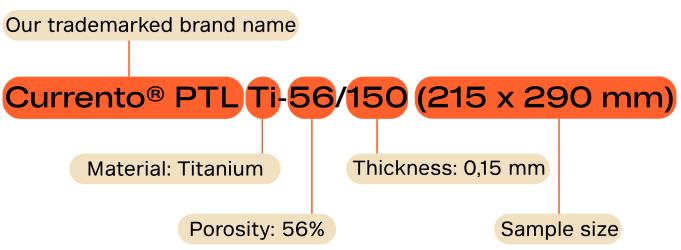We've changed our material codes in 2024. If you're looking for the old material codes, you can find them in this table, together with the new material codes.
You can request a quote on our website.
| Material Code (before 2024) | Material Code (2024) | Thickness | Thickness | Porosity | Surface Area | |
|---|---|---|---|---|---|---|
| Currento® 2NI 06-0,100 | Currento® PTL Ni-66/100 (215 x 290 mm) | 0,10 mm | 0.004 inch | 66% | Normal | |
| Currento® PTL Ni-66/100 (430 x 580 mm) | ||||||
| Currento® 2NI 06-0,200 | Currento® PTL Ni-83/200 (215 x 290 mm) | 0,20 mm | 0.008 inch | 83% | ||
| Currento® PTL Ni-83/200 (430 x 580 mm) | ||||||
| Currento® 2NI 18-0,250 | Currento® PTL Ni-60/250 (215 x 290 mm) | 0,25 mm | 0.010 inch | 60% | ||
| Currento® PTL Ni-60/250 (430 x 580 mm) | ||||||
| Currento® 2NI 30-0,500 | Currento® PTL Ni-66/500 (215 x 290 mm) | 0,50 mm | 0.020 inch | 66% | ||
| Currento® PTL Ni-66/500 (430 x 580 mm) | ||||||
| Currento® 2NI 18-0,500 | Currento® PTL Ni-80/500 (215 x 290 mm) | 80% | ||||
| Currento® PTL Ni-80/500 (430 x 580 mm) | ||||||
| Currento® 2NI 30-1,000 | Currento® PTL Ni-83/1000 (215 x 290 mm) | 1,00 mm | 0.039 inch | 83% | ||
| Currento® PTL Ni-83/1000 (430 x 580 mm) | ||||||
| - | Currento® PTL INC 79/600 (210 x 297 mm) | 0,60 mm | 0.024 inch | 79% | Medium | |
| Currento® PTL INC 79/600 (430 x 580 mm) | ||||||
| - | Currento® PTL NI HR 78/300 (210 x 297 mm) | 0,30 mm | 0.012 inch | 78% | High | |
| Currento® PTL NI HR 78/300 (430 x 580 mm) | ||||||
| - | Currento® PTL NI HR 82/500 (210 x 297 mm) | 0,50 mm | 0.020 inch | 82% | ||
| Currento® PTL NI HR 82/500 (430 x 580 mm) | ||||||
| - | Currento® PTL INC 82/500 (210 x 297 mm) | |||||
| Currento® PTL INC 82/500 (430 x 580 mm) | ||||||
| Currento® 60 BL3 | Currento® PTL SS-74/145 (210 x 297 mm) | 0,15 mm | 0.006 inch | 74% | Normal | |
| Currento® PTL SS-74/145 (430 x 580 mm) | ||||||
| - | Currento® PTL SS-85/1000 (210 x 297 mm) | 1,00 mm | 0.039 inch | 85% | ||
| Currento® PTL SS-85/1000 (430 x 580 mm) | ||||||
| Currento® 20 AL3 | Currento® PTL SS-82/500 (210 x 297 mm) | 0,50 mm | 0.020 inch | 82% | Medium | |
| Currento® PTL SS-82/500 (430 x 580 mm) | ||||||
| Currento® 10 BL3 | Currento® PTL SS-81/200 (210 x 297 mm) | 0,20 mm | 0.008 inch | 81% | High | |
| Currento® PTL SS-81/200 (430 x 580 mm) | ||||||
| Currento® 10 FP3 | Currento® PTL SS-71/260 (210 x 297 mm) | 0,26 mm | 0.010 inch | 71% | ||
| Currento® PTL SS-71/260 (430 x 580 mm) | ||||||
| Currento® 10 AL3 | Currento® PTL SS-78/300 (210 x 297 mm) | 0,30 mm | 0.012 inch | 78% | ||
| Currento® PTL SS-78/300 (430 x 580 mm) | ||||||
| - | Currento® PTL SS-62/410 (210 x 297 mm) | 0,41 mm | 0.016 inch | 62% | ||
| Currento® PTL SS-62/410 (430 x 580 mm) | ||||||
| Currento® 2GDL6-0,150 | Currento® PTL Ti-56/150 (215 x 290 mm) | 0,15 mm | 0.006 inch | 56% | Normal | |
| Currento® PTL Ti-56/150 (430 x 580 mm) | ||||||
| Currento® 2GDL10-0,250 | Currento® PTL Ti-56/250 (215 x 290 mm) | 0,25 mm | 0.010 inch | |||
| Currento® PTL Ti-56/250 (430 x 580 mm) | ||||||
| Currento® 2GDL20-0,500 | Currento® PTL Ti-56/500 (215 x 290 mm) | 0,50 mm | 0.020 inch | |||
| Currento® PTL Ti-56/500 (430 x 580 mm) | ||||||
| Currento® 2GDL20-1,000 | Currento® PTL Ti-56/1000 (215 x 290 mm) | 1,00 mm | 0.039 inch | |||
| Currento® PTL Ti-56/1000 (430 x 580 mm) | ||||||
| - | Currento® PTL Ti-66/200 (215 x 290 mm) | 0,20 mm | 0.008 inch | 66% | ||
| Currento® PTL Ti-66/200 (430 x 580 mm) | ||||||
| - | Currento® PTL Ti-67/200 (215 x 290 mm) | 0,20 mm | 0.008 inch | 67% | ||
| Currento® PTL Ti-67/200 (430 x 580 mm) | ||||||
| - | Currento® PTL Ti-68/350 (215 x 290 mm) | 0,35 mm | 0.014 inch | 68% | ||
| Currento® PTL Ti-68/350 (430 x 580 mm) | ||||||
| - | Currento® PTL Ti-70/750 (215 x 290 mm) | 0,75 mm | 0.030 inch | 70% | ||
| Currento® PTL Ti-70/750 (430 x 580 mm) | ||||||
| - | Currento® PTL Ti-77/2000 (215 x 290 mm) | 2,00 mm | 0.079 inch | 77% | ||
| Currento® PTL Ti-77/2000 (430 x 580 mm) | ||||||
| - | Currento® PTL Ti-78/2000 (215 x 290 mm) | 2,00 mm | 0.079 inch | 78% | ||
| Currento® PTL Ti-78/2000 (430 x 580 mm) | ||||||
| No separate material code existed | Currento® PTL Ti-56/150 PT200 (220 x 290 mm) | 0,15 mm | 0.006 inch | 56% | Normal | |
| Currento® PTL Ti-56/150 PT200 (440 x 550 mm) | ||||||
| Currento® PTL Ti-56/250 PT200 (220 x 290 mm) | 0,25 mm | 0.010 inch | ||||
| Currento® PTL Ti-56/250 PT200 (440 x 550 mm) | ||||||
| Currento® PTL Ti-56/500 PT200 (220 x 290 mm) | 0,50 mm | 0.020 inch | ||||
| Currento® PTL Ti-56/500 PT200 (440 x 550 mm) |

